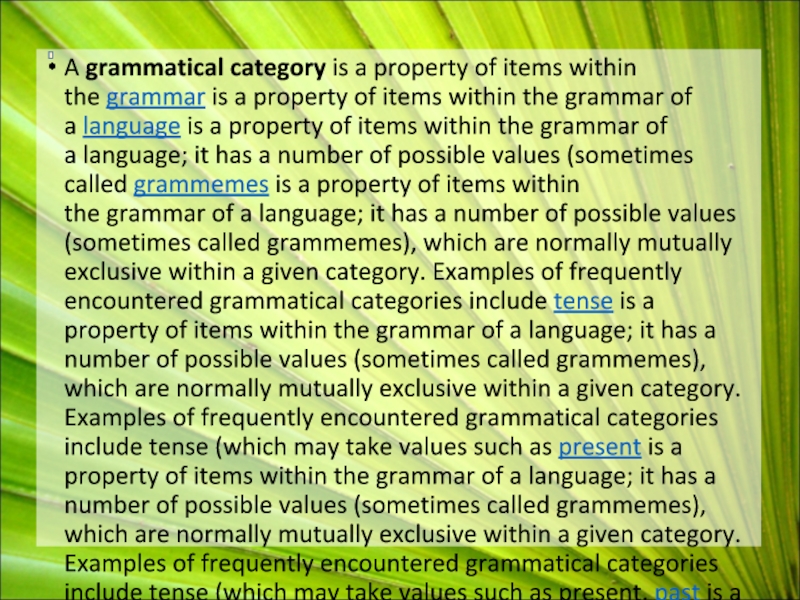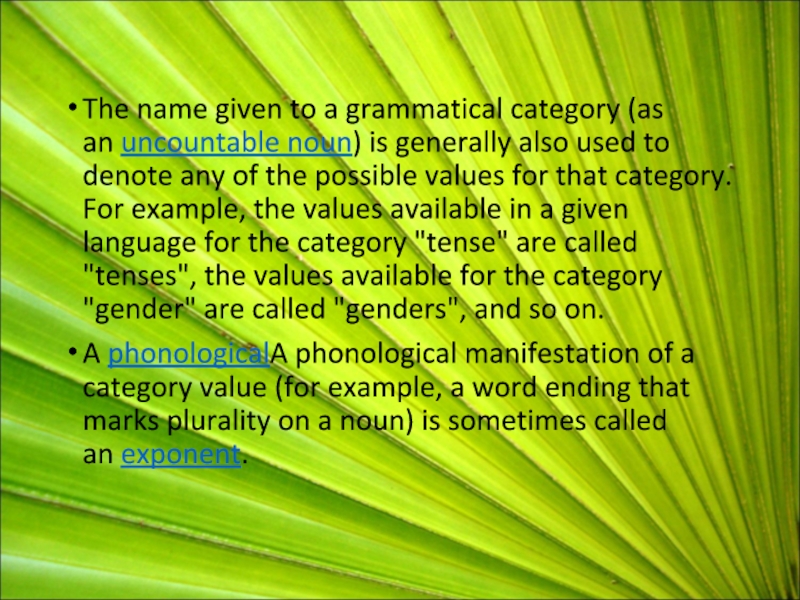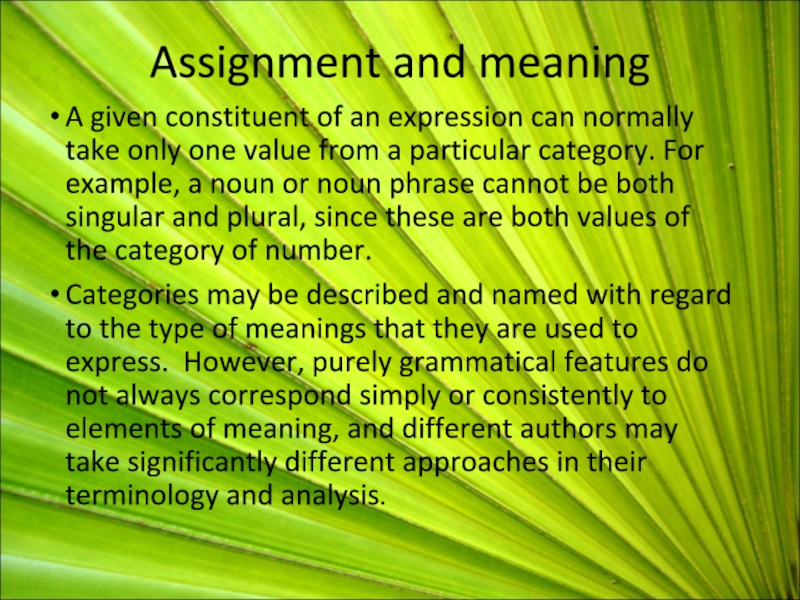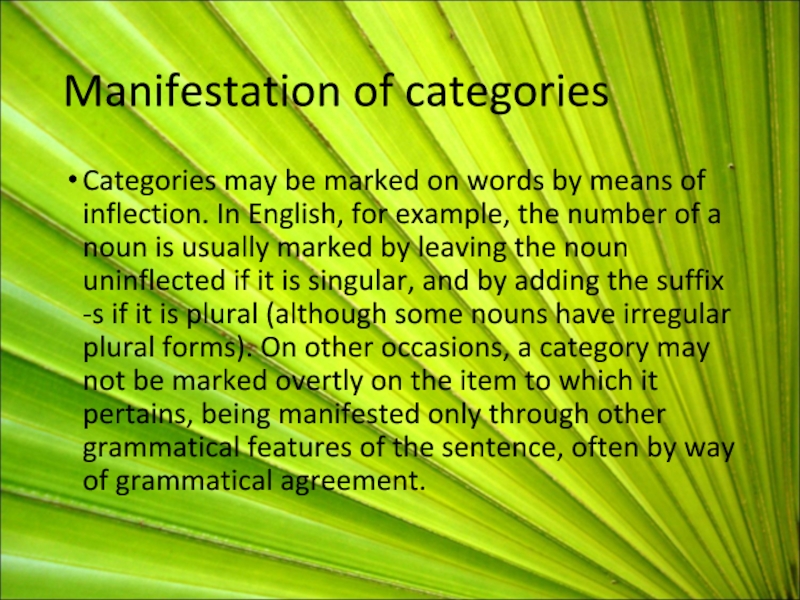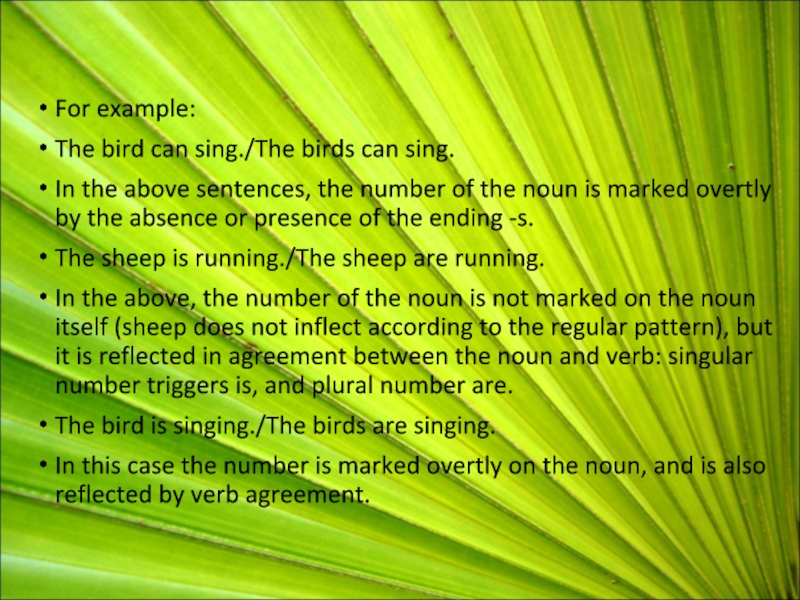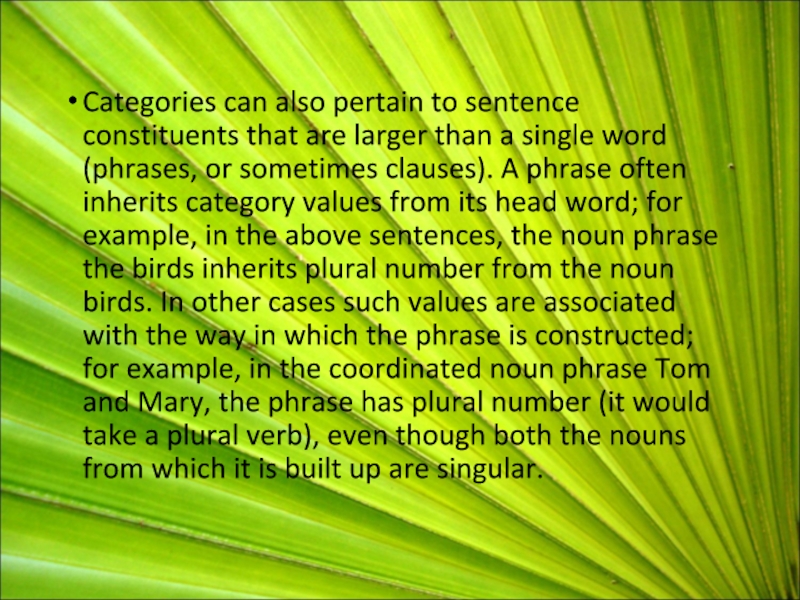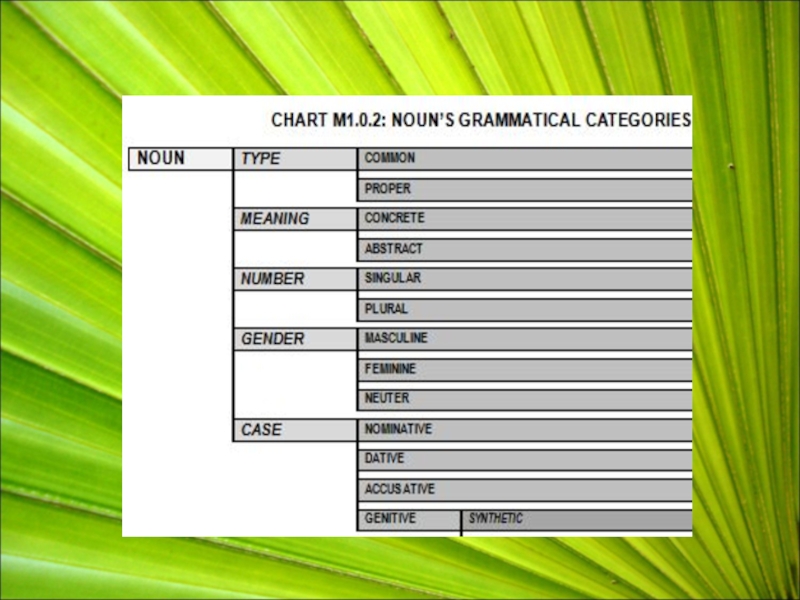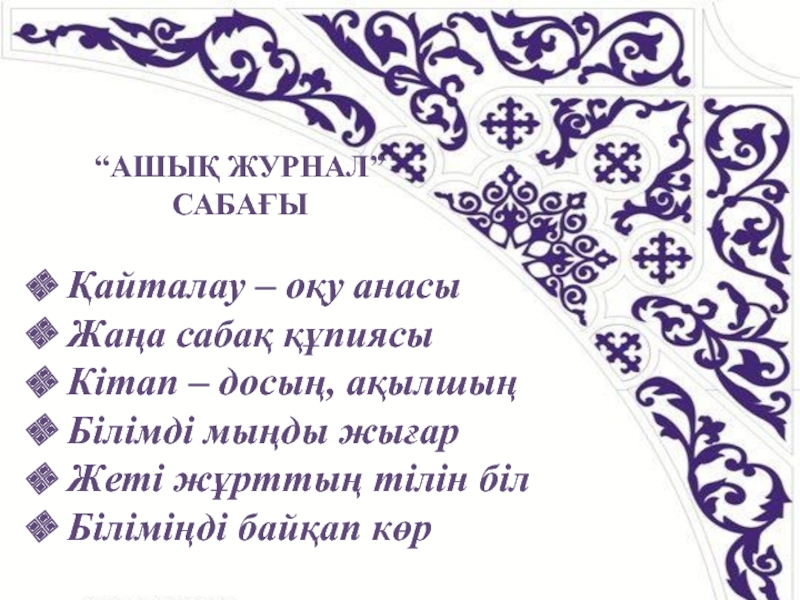- Главная
- Разное
- Образование
- Спорт
- Естествознание
- Природоведение
- Религиоведение
- Французский язык
- Черчение
- Английский язык
- Астрономия
- Алгебра
- Биология
- География
- Геометрия
- Детские презентации
- Информатика
- История
- Литература
- Математика
- Музыка
- МХК
- Немецкий язык
- ОБЖ
- Обществознание
- Окружающий мир
- Педагогика
- Русский язык
- Технология
- Физика
- Философия
- Химия
- Шаблоны, фоны, картинки для презентаций
- Экология
- Экономика
Презентация, доклад по английскому языку на тему Грамматическая категория
Содержание
- 1. Презентация по английскому языку на тему Грамматическая категория
- 2. A grammatical category is a property of items within
- 3. The name given to a grammatical category
- 4. Assignment and meaningA given constituent of an
- 5. Manifestation of categoriesCategories may be marked on
- 6. For example:The bird can sing./The birds can
- 7. Categories can also pertain to sentence constituents
- 8. Слайд 8
A grammatical category is a property of items within the grammar is a property of items within the grammar of a language is a property of items within the grammar of a language; it has a number of possible values (sometimes called grammemes is a property of items
Слайд 2A grammatical category is a property of items within the grammar is a property of
items within the grammar of a language is a property of items within the grammar of a language; it has a number of possible values (sometimes called grammemes is a property of items within the grammar of a language; it has a number of possible values (sometimes called grammemes), which are normally mutually exclusive within a given category. Examples of frequently encountered grammatical categories include tense is a property of items within the grammar of a language; it has a number of possible values (sometimes called grammemes), which are normally mutually exclusive within a given category. Examples of frequently encountered grammatical categories include tense (which may take values such as present is a property of items within the grammar of a language; it has a number of possible values (sometimes called grammemes), which are normally mutually exclusive within a given category. Examples of frequently encountered grammatical categories include tense (which may take values such as present, past is a property of items within the grammar of a language; it has a number of possible values (sometimes called grammemes), which are normally mutually exclusive within a given category. Examples of frequently encountered grammatical categories include tense (which may take values such as present, past, etc.), number is a property of items within the grammar of a language; it has a number of possible values (sometimes called grammemes), which are normally mutually exclusive within a given category. Examples of frequently encountered grammatical categories include tense (which may take values such as present, past, etc.), number (with values such as singular, plural is a property of items within the grammar of a language; it has a number of possible values (sometimes called grammemes), which are normally mutually exclusive within a given category. Examples of frequently encountered grammatical categories include tense (which may take values such as present, past, etc.), number (with values such as singular, plural, and sometimes dual is a property of items within the grammar of a language; it has a number of possible values (sometimes called grammemes), which are normally mutually exclusive within a given category. Examples of frequently encountered grammatical categories include tense (which may take values such as present, past, etc.), number (with values such as singular, plural, and sometimes dual), and gender (with values such as masculine, feminine and neuter).
Although terminology is not always consistent, a distinction should be made between these grammatical categories (tense, number, etc.) and lexical categories, which are closely synonymous with the traditional parts of speech (noun, verb, adjective, etc.), or more generally syntactic categories (noun, verb, adjective, etc.), or more generally syntactic categories. Grammatical categories are also referred to as (grammatical) features.
Although terminology is not always consistent, a distinction should be made between these grammatical categories (tense, number, etc.) and lexical categories, which are closely synonymous with the traditional parts of speech (noun, verb, adjective, etc.), or more generally syntactic categories (noun, verb, adjective, etc.), or more generally syntactic categories. Grammatical categories are also referred to as (grammatical) features.
Слайд 3
The name given to a grammatical category (as an uncountable noun) is
generally also used to denote any of the possible values for that category. For example, the values available in a given language for the category "tense" are called "tenses", the values available for the category "gender" are called "genders", and so on.
A phonologicalA phonological manifestation of a category value (for example, a word ending that marks plurality on a noun) is sometimes called an exponent.
A phonologicalA phonological manifestation of a category value (for example, a word ending that marks plurality on a noun) is sometimes called an exponent.
Слайд 4Assignment and meaning
A given constituent of an expression can normally take
only one value from a particular category. For example, a noun or noun phrase cannot be both singular and plural, since these are both values of the category of number.
Categories may be described and named with regard to the type of meanings that they are used to express. However, purely grammatical features do not always correspond simply or consistently to elements of meaning, and different authors may take significantly different approaches in their terminology and analysis.
Categories may be described and named with regard to the type of meanings that they are used to express. However, purely grammatical features do not always correspond simply or consistently to elements of meaning, and different authors may take significantly different approaches in their terminology and analysis.
Слайд 5Manifestation of categories
Categories may be marked on words by means of
inflection. In English, for example, the number of a noun is usually marked by leaving the noun uninflected if it is singular, and by adding the suffix -s if it is plural (although some nouns have irregular plural forms). On other occasions, a category may not be marked overtly on the item to which it pertains, being manifested only through other grammatical features of the sentence, often by way of grammatical agreement.
Слайд 6
For example:
The bird can sing./The birds can sing.
In the above sentences,
the number of the noun is marked overtly by the absence or presence of the ending -s.
The sheep is running./The sheep are running.
In the above, the number of the noun is not marked on the noun itself (sheep does not inflect according to the regular pattern), but it is reflected in agreement between the noun and verb: singular number triggers is, and plural number are.
The bird is singing./The birds are singing.
In this case the number is marked overtly on the noun, and is also reflected by verb agreement.
The sheep is running./The sheep are running.
In the above, the number of the noun is not marked on the noun itself (sheep does not inflect according to the regular pattern), but it is reflected in agreement between the noun and verb: singular number triggers is, and plural number are.
The bird is singing./The birds are singing.
In this case the number is marked overtly on the noun, and is also reflected by verb agreement.
Слайд 7
Categories can also pertain to sentence constituents that are larger than
a single word (phrases, or sometimes clauses). A phrase often inherits category values from its head word; for example, in the above sentences, the noun phrase the birds inherits plural number from the noun birds. In other cases such values are associated with the way in which the phrase is constructed; for example, in the coordinated noun phrase Tom and Mary, the phrase has plural number (it would take a plural verb), even though both the nouns from which it is built up are singular.

